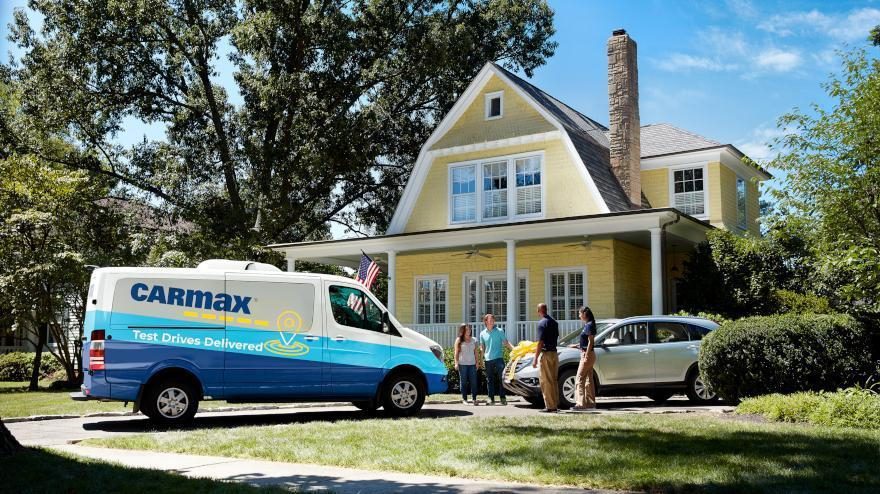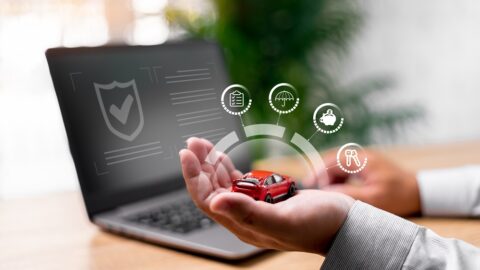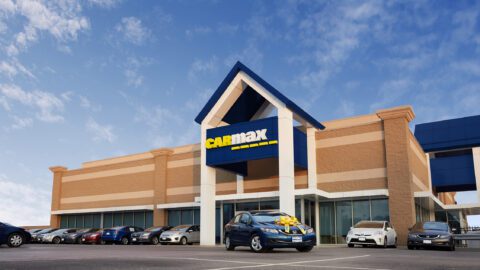 CarMax may be best known for a traditional in-store buying experience, but the used car retailer is delivering on a concept that blurs the lines of when and where consumers can shop for, and even test drive, their desired new car.
CarMax may be best known for a traditional in-store buying experience, but the used car retailer is delivering on a concept that blurs the lines of when and where consumers can shop for, and even test drive, their desired new car.
In October 2016, CarMax launched a home delivery pilot in North Carolina using a one-hour process involving four employees. Findings from the pilot enabled the company to streamline delivery down to a 15-minute process requiring just two employees to drop off the customer’s car. In December 2018, the company launched a “customer experience center” in Atlanta, designed to enable shoppers to buy a car as well as consult over the phone or online without ever having to enter a dealership, and even to test drive the prospective purchase in their own neighborhood.
In an interview with Retail TouchPoints, Jim Lyski, CMO of CarMax reveals:
- How CarMax gives consumers confidence and control over the buying process by educating them on products and prices, even offering the option to test drive at home before they commit to buying;
- Why CarMax looked to companies like Starbucks, Amazon and Netflix as it developed its omnichannel strategy and evolved with shopper expectations;
- The goal to scale the customer experience center business model to more than 50% of all U.S. shoppers by February 2020; and
- The role CarMax “customer experience consultants” or “CXCs” play in the new buying process, and how they affect the roles of traditional in-store associates.
Retail TouchPoints (RTP): Given that cars are such a high-consideration purchase, one that often needs to be made in person, how has CarMax built a model that boosts shopper confidence about online purchases?
Jim Lyski: This is definitely a significantly considered purchase and one that most consumers do not make with any frequency. It can be four, five or six years between purchases. Given that consideration, it feels like a high-risk proposition to the consumer, so what we try to do to alleviate that feeling is give them both confidence and control over the process.
To boost confidence, we try to educate them. We provide the content on the web site, and information at their fingertips that allows them to self-educate and alleviate some questions that they may have. They may wonder how many of the available cars they can afford, so we have online appraisal and financing tools that allow them to get a ballpark figure of what level of monthly payments they can afford.
On the control side, we give them tools like our checkout hub that allows them to see where they are within a buying journey, and to start and stop whenever they want without losing any of the work that they’ve done. They can go at their own pace and they don’t feel pressure to hurry up and make a decision. That leveraging of confidence and control have helped that consumer get through the car-buying journey and feel good about it, instead of having that buyers’ remorse that most people have after purchasing a used vehicle.
Also, we’ve tried to give the consumer the option to test drive before they buy. Let’s say you do everything at home and you’re pretty serious about the car. We don’t make you buy it first, and then deliver it to you. We’ll actually deliver it to you in the states that allows us to do so, let you drive it around the block and then decide whether you’re confident in the car.
Since our founding we have focused on having high integrity in all our interactions, and at the center of that is being super transparent. That transparency calms the waters, and gives the consumer a sense that they are dealing on equal footing versus being at a disadvantage — which is the feeling consumers generally have at a used car retailer.
RTP: What was the research process like as far as developing an online presence? Were there any tidbits from other e-Commerce success stories that you took when crafting an omnichannel business model?
Lyski: There’s a couple angles to that. The way we do research now is very much behavioral or observational research. We don’t ask customers lots of questions of what they think. We put experiments out in the marketplace and we watch what they do. We are big believers in this experimentation approach to honing our products and services.
As far as what we’ve learned from other world-class retailers, the primary thing we discovered is that the consumer used to evaluate retailers in a silo: ‘I’m buying shoes so I’ll evaluate all the shoe retailers against each other. I’m buying used cars so I’ll evaluate all the used car retailers against each other.’
What’s flipped over the past four or five years is that the consumer now evaluates all brands across all industries. If I’m getting this exceptional experience at Starbucks where my mobile app is totally linked into my in-store experience, why can’t I have that everywhere? I’m getting that for a $5 cup of coffee, but why can’t I get that with a $15,000 used car?
We’ve looked at those experiential moments at great online and physical retailers and assumed that that’s the new expectations of our consumers, and built against that.
With great companies like Amazon and Netflix driving shopper expectations, personalization of the experience is super important. We’ve taken our massive data advantage and turned that toward the consumer. We want to make sure we’re giving them an experience that is unique to them, so that they can do as much or as little online or in the store, or a combination of both, as they want. That’s something else that sets us apart.
RTP: How many markets is the omnichannel buying experience in now? What did you take away from the Atlanta experience implementation as far as best practices as you continue rolling out the experiences elsewhere?
Lyski: We started in Atlanta, and you could view Atlanta as the beta version of our omnichannel experience. We didn’t have everything completely built, but we rolled out the overall experience there to see what the consumer’s receptivity was to that, as well as discover how effective we were operationally in delivering an exceptional experience.
That started at the beginning of this year all the way into June. In June, we rolled out 1.0 of our omni operation to all of Florida, and now we’re in Florida, Georgia, Virginia and North Carolina. Our intent is to give more than 50% of all of our consumers access to our omnichannel experience by February 2020.
It’s all hands on deck. Unlike a software company where you can do an update and ‘boom,’ everybody has it, we had to really do this well. We had 25,000 field associates working in our store and customer experience centers that we have to hire, train and educate on the new experience. That’s why we have to pace it out a bit. We’re going at a very quick speed to get this across the nation as soon as we can.
RTP: What role do the CarMax ‘customer experience consultants’ play, particularly in ensuring that going from one channel to another is seamless?
Lyski: Our customer experience consultants, called ‘CXCs,’ who are located in our customer experience centers, play the linchpin role in the whole process. One thing we discovered is, very few consumers want to stay within one channel throughout the entire process. Very few consumers want to start online, stay online and get their car delivered to their home, and very few want to only work through the store environment.
More than nine out of 10 consumers want to start online, do part of the transaction offline and then do the balance of transaction in a store. To be able to bridge all those activities and to ensure that the consumer is really feeling the seamlessness of the experience, the CXC is there to answer questions and provide guidance whenever the consumer wants throughout the process. It’s a really important role for us.
RTP: How do the roles of traditional in-store associates change now that the CXCs are in place, particularly if they have to work with shoppers who have already started the buying process online? Are they given tech to supplement this?
Lyski: The previous experience was that a consumer would walk in a store, and the sales consultant in the store would basically know nothing about them, whether they scheduled an appointment or not. We knew that to deliver a great seamless experience that we would need the sales consultant in-store to know as much as the customer experience consultant online.
We re-platformed both the customer experience center technology as well as the store legacy systems on the same CRM platform, Salesforce. Leveraging Salesforce across all environments allows us to capture information regardless of location, and then you share that across all associates so that consumer never has to repeat their story, they never have to re-enter data they have already entered. We can create something that’s location-agnostic to deliver a real world-class omnichannel experience.











